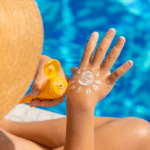The adventure of getting your baby into the pool for the first time can even yield a series of cute photos — like the image that illustrates this article. But, without a doubt, it is a decision that divides fathers and mothers all over the world, especially when we put the safety of the little ones on the agenda.
Is chlorine very dangerous? Can I apply sunscreen? What is the ideal age to put the child in the water safely? These are questions, whose answers also divide many experts, since there is no consensus on the subject.
However, there are good practices you can follow to protect your child as much as possible and let them enjoy the space without worries. Follow up!
When entering the pool with the baby, why does chlorine become a concern?
One of the main doubts that surround the topic of baby safety in the pool concerns chlorine: if it serves precisely to purify the water, what is the reason to raise concerns when we talk about the little ones?
The answer is simple: chlorine, like other products used in routine water treatment, is a chemical solution. This means that it can have more intense effects on babies, as their immune system is still developing.
In addition, if the chemical balance of the water is compromised — with too much or too little chlorine, for example — there is a risk of developing injuries to the eyes, mouth and skin, as the baby’s body is still very fragile.
But it’s not all a headache, as when it’s at stable levels (between 1.0 and 3.0 ppm), chlorine is usually harmless to children and, in fact, helps ensure a safer and healthier bath.
So, to ensure this stability in the chemical parameters of the pool, it is essential that the treatment is done correctly and that the chlorine levels are always checked with the Chlorine and pH Test Kit.
Just adjust the chlorine and everything ok?
Not quite. After all, in addition to all the chlorine problem, the question of the minimum age for the baby to come into contact with water from an external environment is also in question.
Look: the best age to take the baby to the pool is a subject that still divides pediatricians’ opinions and, in the end, the right thing is that the decision is evaluated by the parents with the doctor.
Remember that it is necessary to take into account the particularities of each child – some are more likely to develop allergies, while others may have their respiratory system still developing, increasing the risk of choking on water.
Here, a good tip that can be put into practice even before taking the baby to the pool is to stimulate his relationship with the water. At home, during the bath, parents can encourage him to play in the bathtub, as this will certainly help him to develop a more friendly relationship with this environment — always, of course, with supervision!
Don’t forget to also take care of the temperature of the pool.
Anyone who is used to bathing in a pool on hot days knows that that traditional thermal shock when entering the cold water dissipates in a matter of a few minutes, right?
But with babies, things change, because they have more difficulty regulating their body temperature and, therefore, you need to check the water temperature before putting them in the pool.
Keep in mind that for little ones, the ratio of skin surface area to body weight is much higher. In other words, babies are more sensitive to freezing water and even room temperature than an adult.
So if the water is cold for you, it is definitely too cold for your baby. Ah, the same goes for heated pools, as too hot water can cause a frame of intense fever in younger children.
In short, putting your baby in the pool can mean a pleasant and healthy interaction for you and your child, and potentially prevent your baby from developing some sort of fear of water.
However, you should only do this if you are sure that the environment is safe, which includes taking into account all the important precautions that we have listed here, which apply to both your home pool and collective spaces in clubs or condominiums.
Check other blogposts here:

The ultimate DIY guide to installing your fiberglass pool:
DIY Fiberglass pool – Installing a fiberglass pool in your backyard is an exciting project that can transform your outdoor space into a personal oasis.

Building your dream pool: The complete guide to DIY Fiberglass pool kits.
DIY Fiberglass pool – Have you ever imagined turning your backyard into a luxurious oasis, complete with your own sparkling pool?The idea of having a

DIY Fiberglass Pools: As aeasy guide to building your own
DIY Fiberglass Pools – Building your own pool can seems like a hard task, but with the right materials and guidance, it can also be

Your Complete Guide to Preparing for Pool Season
When entering the summer season our expectations of an amazing summertime is always full of moments of joy and love. To guarantee your perfect summer


